

Learn How Photography Was Discovered - The F/Stop Spot. Whether you’re a seasoned photographer or just diving in for the first time, it’s important to have a general understanding of how photography started.
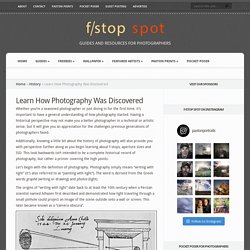
Having a historical perspective may not make you a better photographer in a technical or artistic sense, but it will give you an appreciation for the challenges previous generations of photographers faced. Additionally, knowing a little bit about the history of photography will also provide you with perspective further along as you begin learning about f-stops, aperture sizes and ISO. This look backwards isn’t intended to be a complete historical record of photography, but rather a primer covering the high points. Let’s begin with the definition of photography. Photography simply means “writing with light” (it’s also referred to as “painting with light”). Camera Obscuras Were Simply Darkened Rooms with a Small Hole in One of the WallsA 16th Century Pictorial Representation of a Camera Obscura Harry Ransom Center and J.
Litchfield, R. Shana and Robert ParkeHarrison : Architect's Brother : Passage. Paul Nicklen - Photography. Biography - Fondation Henri Cartier-Bresson. To tell Henri Cartier-Bresson’s story and to unravel his work is essentially to tell the story of a look.
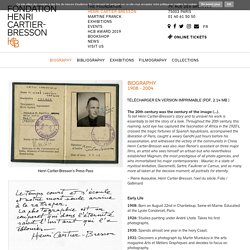
Throughout the 20th century, this roaming, lucid eye has captured the fascination of Africa in the 1920’s, crossed the tragic fortunes of Spanish republicans, accompanied the liberation of Paris, caught a weary Gandhi just hours before his assassination, and witnessed the victory of the communists in China. Henri Cartier-Bresson was also Jean Renoir’s assistant on three major films, an artist who sees himself an artisan but who nevertheless established Magnum, the most prestigious of all photo agencies, and who immortalised his major contemporaries : Mauriac in a state of mystical levitation, Giacometti, Sartre, Faulkner or Camus, and as many more all taken at the decisive moment, all portraits for eternity. – Pierre Assouline, Henri Cartier-Bresson, l’oeil du siècle, Folio / Gallimard Early Life.
Frans Lanting: The story of life in photographs. Frans Lanting: The story of life in photographs. Photographs that changed photography. Eugene Atget's Rue de Seine, 1924 Rue de Seine is one of the most reproduced images by the French photographer from his important archive of Paris.
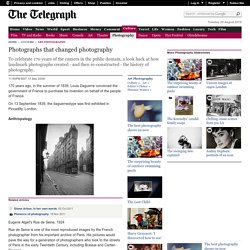
Sandy Skoglund Art Site. A Woman’s Eye: How Imogen Cunningham broke through gender barriers to help redefine modern photography. "So many people dislike themselves so thoroughly that they never see any reproduction of themselves that suits.
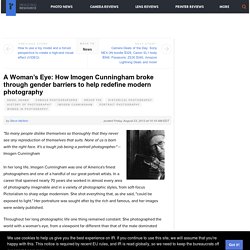
None of us is born with the right face. It's a tough job being a portrait photographer. " -- Imogen Cunningham. The History of Photojournalism and Its Lasting Impact on Society. Photojournalist James Nachtway on duty in Rwanda during the genocide of 1994. (Photo: Christian Fei) Using images to communicate the news, photojournalism has shaped the way we view the world since the mid-19th century. What began as war photography has slowly spread to other newsworthy events, including sports, and even long-form storytelling through photo essays. Lewis W. Hine. Lewis Hine was trained to be an educator in Chicago and New York.
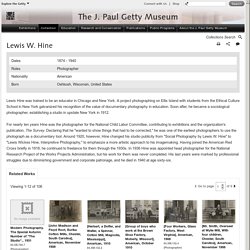
A project photographing on Ellis Island with students from the Ethical Culture School in New York galvanized his recognition of the value of documentary photography in education. Soon after, he became a sociological photographer, establishing a studio in upstate New York in 1912. For nearly ten years Hine was the photographer for the National Child Labor Committee, contributing to exhibitions and the organization's publication, The Survey. Declaring that he "wanted to show things that had to be corrected," he was one of the earliest photographers to use the photograph as a documentary tool.
The 24 Best Vintage Cameras to Buy. If the Mamiya 7 II is too far out of your price range, get this.

The Fuji GW690III is a rangefinder-style camera, just like the Mamiya, but offers slightly lower-grade optics and a greatly reduced price. It is known as the “Texas Leica” because of its hefty build quality and size. The other thing that the Fuji has going for it over the Mamiya is its massive 6 x 9 negatives. This giant negative size translates to higher-quality images and the ability to print them larger if that’s your jam. Related Video: Lecia Q2 Review Volume 0% Press shift question mark to access a list of keyboard shortcuts Keyboard Shortcuts play/pause increase volume decrease volume. Elaborate Photomontages by Suzanne Moxhay Inspired by Matte Painting. The surreal and unsettling landscapes of British artist Suzanne Moxhay are views into apocalyptic worlds made through photomontage.
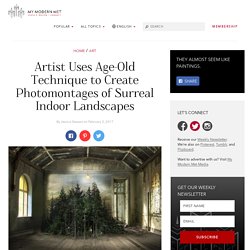
By mixing her own photography with archival images, she carefully crafts haunting tableaus. To achieve the end result, Moxhay uses an early 20th-century technique called matte painting. Originally used in cinema, artists would paint artwork on glass panels that would then be integrated with filmed footage. The result is a seamless environment that would have otherwise been impossible to achieve in its era of invention. Moxhay brings this theatrical sensibility to her work, with pieces that seem as though they are film stills. By using traditional cut and paste collage, as well as digital manipulation, Moxhay brings viewers into a world that is slightly off. Jerry Uelsmann: Visual Poetry.